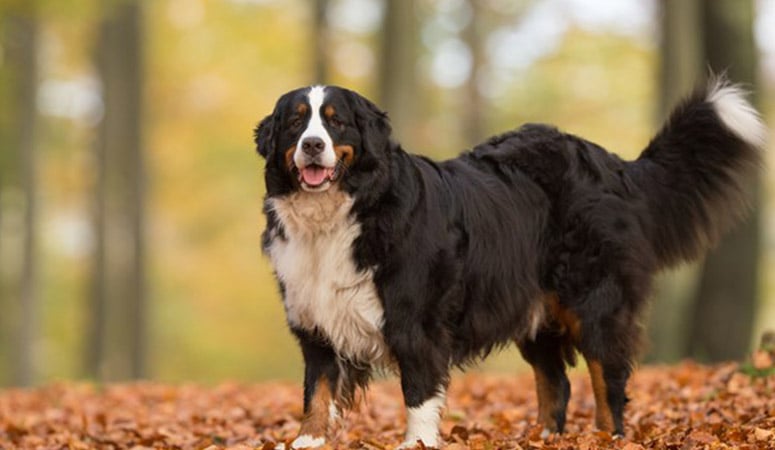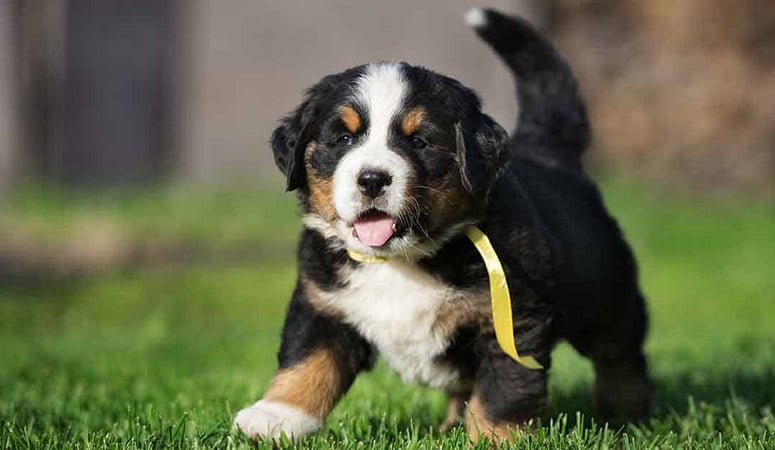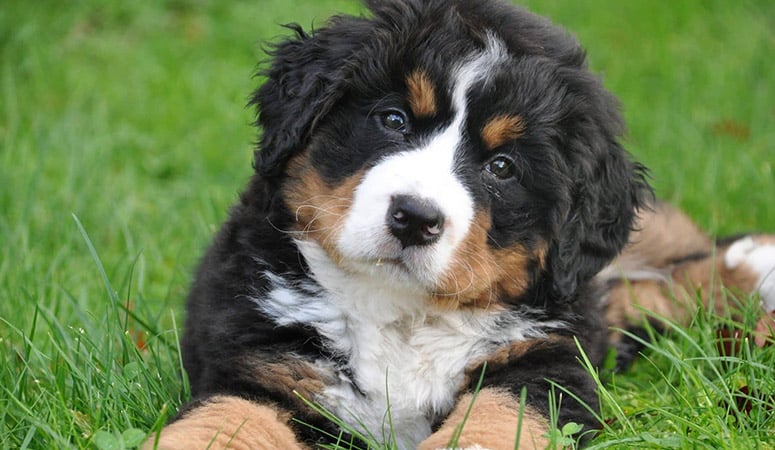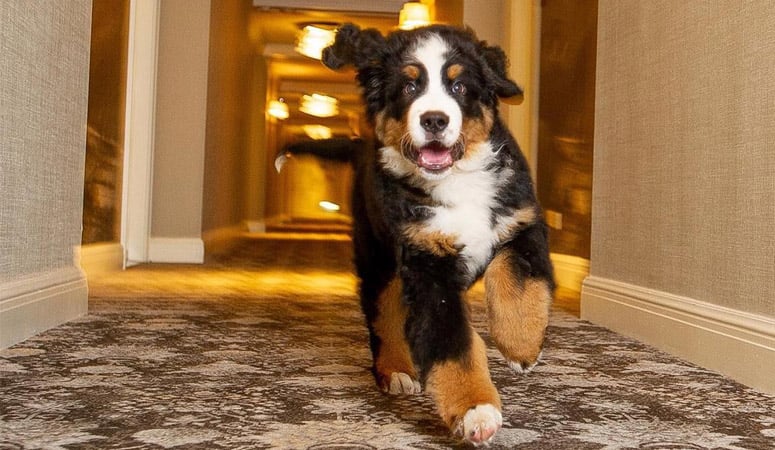Bernese Mountain Dog
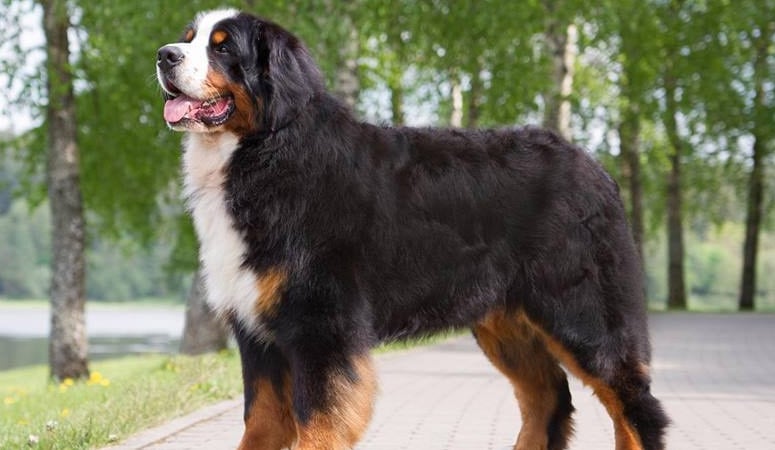
The Bernese Mountain Dog is big, powerful, sturdy with a combination of a sweet and friendly nature. This breed is an extremely adaptable working dog from the farmlands of Switzerland, with eagerness to please, social by nature, doesn’t like being left alone. Their coat is thick, long, and slightly wavy, to withstand the cold.
| Other Names | Berner Sennenhund |
| Color | Black Rust & White, Black Tan & White, Black & Rust, Black & White, Rust & White |
| Height | Males: 25-28 inches. Females: 23-26 inches. |
| Weight | Males: 85-110 pounds. Females: 80-105 pounds. |
| Life Span | 7-10 years |
| Personality | Good-Natured, Calm, Strong |
| Exercise | Energetic |
| Origin |
| Popularity | #23 |
| Groom Needs | 2-3 Times a Week |
| Kids Friendly | Yes with supervision |
| Dog Friendly | Yes |
| Watch Dog | |
| Family Dog | Yes |
| Litter Size | 5-7 |
Bernese Mountain Dog Pictures
Bernese Mountain Dog Video
Introduction
Originally bred as farm dogs, the tri-colored Bernese Mountain Dog is a large and sturdy breed that is adapted for heavy work such as pulling large cheese wagons. They appear beautiful and amicable in their thick, silky double-coat of black, white, and rust colors.
Owing to their large size, it is normal for a standard male to weigh within pounds range of 85-110, or 70-95 for a female. The female Bernese dog runs smaller than the male — where a male dog stands at around 26 or 28 inches, the female manages to reach a shoulder height of 22-26 inches. They have slowly climbed up the rungs of the popularity ladder and today, Bernese Mountain Dogs are rated 22nd most popular dog breed by the American Kennel Club. This dog breed is hardy to harsh conditions and would possibly live up to around 8 or 10 years on average.
Living with Bernese Mountain Dog
The Bernese Mountain Dog has a double coat, with a longer outer coat and a wooly undercoat, and Bernese doesn’t shed heavily except the shedding season in the spring and fall. Weekly brushing is enough for your Bernese, and daily brushing is necessary for the undercoat to help remove the dead hair and keep the dog looking best during the shedding season.
Usually, Periodic bathing is enough to maintain your dog’s neat appearance, such as once every couple of months.
Their ears can trap bacteria, dirt, and liquid, so weekly cleanings are recommended to prevent painful and ear infections. Also, you need to brush your dog’s teeth at least two or three times a week to reduce tartar and bad breath, and the daily brush is better to keep a fresh breath.
Active Berners could naturally wear their toenails down to a good length, but some do not. If you can hear your dog click the hard floor, it means they are too long. Trim their nails regularly to the nail’s pain and structural problems.
As the Bernese Mountain Dog is a working dog, they have plenty of energy, so daily exercise is needed to burn their energy and stay healthy and happy, such as 30 minutes of vigorous exercise or yard play additionally. Overeating and obesity may be the focus of this breed; regular exercise will help maintain a healthy weight.
Although they definitely meant to live indoors with their human family, Berners enjoy the outdoor activities and to be great companions during long journeys or hiking. Owners of outdoor often take their canine companions on camping and backpacking trips. And Berners likes to pull young children with carts, and some even participate in go-karting and drafting competitions.
Since hot weather can cause Bernese Mountain Dogs to overheat, a warm climate could be difficult for them, they enjoy cold weather more.
Bernese mountain dogs tend to stay in good weight or be slightly overweight. It is generally recommended to feed your dog three to five high-quality dry dog food per day based on the dog’s average weight and activity level. This amount should be divided between two or three meals, or it can be offered in a food-dispending puzzle toy. Besides, Bernese Mountain Dogs may suffer from gastric dilatation volvulus or bloat, so it is suggested to avoid feeding after exercise and giving small meals multiple times per day.
If the dog starts to gain too much weight, calories should be restricted, and adult dogs should be fed a balanced diet. The puppies should be fed large-breed growing foods, which will slow down their growth rate but not the final size. This can reduce the incidence or severity of hip dysplasia in adults.
Treats could be an important aid in training, but excessive intake can lead to obesity, and there should be clean fresh water at all times.
The Bernese Mountain Dog is a short life dog breed and is often suffer from breed-specific health problems. Breeders should screen for your dog’s health conditions, such as blood diseases, hip and elbow dysplasia, progressive retinal atrophy, and certain cancers. All large dog breeds are prone to bloat, which is a sudden, life-threatening stomach disease. The owners should learn what signs to pay attention to and what to do when happens.
Suggested tests:
Elbow Evaluation
Cardiac Exam
Hip Evaluation
Ophthalmologist Evaluation
Von Willebrand’s Disease DNA Test
Total Annual Cost: $3889
Cost is estimated for the first year and may vary depending on many factors, such as dog food, health care, leash, collar, licensing, possible fencing, crates, training and obedience classes, dog-walking, grooming, treats, toys, flea, tick, and heart-worm meds, microchips, etc.
The Bernese Mountain Dogs are usually easy to train as they are smart and eager to please. They are also affectionate and openhearted and can easily feel hurt, so they do not respond well to harsh corrections or training methods. It would cause bad behaviors if your Berner often left alone for a long time, as Berners like to be with family.
It is easy to train and learns basic obedience to Bernese Mountain Dogs, and they respond best to positive reinforcement. Early training is important for Berners to help socialize and teach the limits. In this slow-maturing breed, puppyhood lasts longer, so patience and persistence are key.
Bernese Mountain Dogs are eager to please and work diligently to learn new things, they can learn advanced skills and do well in obedience competitions and agility. Besides, Bernese Mountain Dogs can be used in search and rescue, and their friendly nature and love of people make them ideal animal-assisted therapy dogs. As Berners grow slowly, agile training should be in a slow and steady way to prevent damage to bone and joint growth.
History
The Bernese Mountain Dog has quite an interesting history, in that they almost ran into extinction at a time before the breed was rejuvenated. There are reasons to believe the theories linking it to a Swiss origin, and they were initially called the Durbacher, named for the place where their ancestors were bred in large numbers.
It is widely believed that the Bernese Mountain Dog originated, in the main, from the district of Berne in Switzerland, hence the name. A member of a family of four Swiss mountain dogs (the Sennenhund-type dogs), which include the Appenzeller Sennenhund, the Greater Swiss Mountain Dog, and the Entlebucher Mountain Dog, the Bernese Mountain Dog has also been connected to the ancient Roman Molosser breed.
The breed directly resulted from a cross between some native Swiss mountain dogs and Roman military dogs brought during the era of the invasion of old Switzerland. Large dogs of remarkable power which were well-suited as multipurpose farm dogs were created. The Bernese dog assisted with pulling milk and cheese carts, guarding farmholds, and even driving livestock across far distances.
Towards the latter part of the 19th century, the Bernese dogs began to thin out in the population, perhaps due to poor breeding technology in their home. It was Herr Franz Schertenleib, a Swiss cynologist, who came to the rescue, and soon after, the Bernese Mountain Dogs were back in the yards again. Gradually, the Bernese Mountain Dog began to grow in prominence and favor, and in the early 1900s, the Bernese Mountain Dog saw its way into dog show for the first time. The first breed club, the Schweizerische Dürrbach-Klub, was founded in Burgdorf in 1907. Ever since the Bernese Mountain Dog slowly began to gain recognition in other countries.
Helpful Information
Breed Club: BERNESE MOUNTAIN DOG CLUB OF AMERICA,INC.
Breed Club Link: http://www.bmdca.org/
Breed Club Rescue: BMDCA National Rescue & Rehome Committee
Breed Club Rescue Link: http://www.bmdca.org/rescue/

